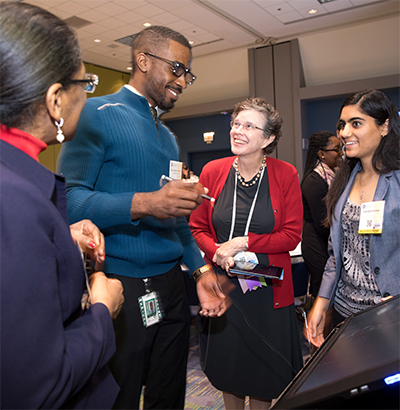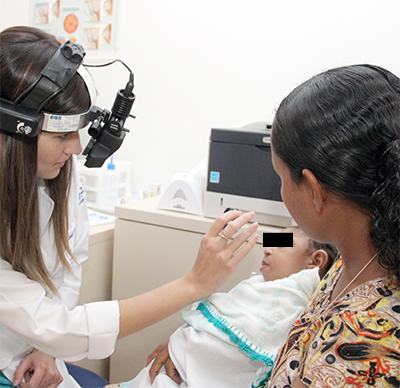Creating Opportunities to Further Our Profession at Home and Abroad

Medical students attended a student engagement day at AAO 2016. They learned about the many subspecialty areas from which to choose in ophthalmology and about the diseases that most affect minority populations.
The world is a better place when all communities have access to high-quality eye care. The Academy invests in patients and our profession two-fold: By attracting underrepresented U.S. medical students to ophthalmology, and by providing Academy resources to students and practicing ophthalmologists in developing countries.
New this year, the Minority Ophthalmology Mentoring Program and its inaugural Student Engagement Day launched at AAO 2016. A collaboration with the Association of University Professors of Ophthalmology, this pilot program is designed to attract underrepresented medical students to ophthalmology to more accurately reflect the patient population. As part of the program, the Academy matched 18 students with ophthalmologists who will mentor them for the coming years, helping them prepare to be competitive when applying for the residency match.
The Academy conducts activities in an effort to decrease worldwide blindness alongide the greater global ophthalmology community. Through its Global Outreach programs, the Academy supplies colleagues in developing nations who have limited educational resources. This Academy Foundation–supported collaboration works to ensure that patients throughout the world have access to quality eye care.
For example, the Academy partners with international ophthalmic societies to provide access to the ONE Network. Last year, the Academy granted ONE Network access to 35,901 ophthalmologists in 61 developing countries, allowing them to use the most current news and the latest clinical education resources.
Each year, the Academy also provides hundreds of educational materials to ophthalmology residency programs in developing countries. In 2016, the Education Distribution Project provided more than 100 full sets of the 13-volume Basic and Clinical Science Course. The project sent an additional 125 sets to these programs in partnership with the International Council of Ophthalmology. AAO 2016 attendees from developing countries also took home a total of 400 bags of books and DVDs through the project.
And through the Host an Ophthalmologist Program and Rotary Club Host Project, the Academy helps ophthalmologists attend the Academy’s annual meeting. These opportunities provide invaluable educational, professional and networking experiences. Last year, the programs brought a total of 41 ophthalmologists to AAO 2016, where they learned new skills and techniques to share with colleagues upon their return home.
Enabling Physicians to Make an Impact Around the World

Camila V. Ventura examines a baby with microcephaly in Recife, Brazil. Her video, “Zika Virus and the Eye,” is included the GO Guide, a valuable resource for ophthalmologists practicing or planning to practice in developing countries.
At AAO 2016, the Academy launched the Global Directory of Training Opportunities. This is a new resource for ophthalmologists seeking training opportunities outside their countries. It provides basic information and links to fellowships, observerships and externships from around the world, including Europe, Latin America, Africa, the Asia Pacific, the Middle East and North America.
The Academy’s Global Ophthalmology (GO) Guide continues to serve as a valuable resource for ophthalmologists working in underserved areas and developing countries. Now in the third year in the online ONE Network, the Academy expanded its reach of this effort, resulting in more ophthalmologists using the guide than ever before.
The GO Guide includes several online CME courses for physicians who want to work overseas, including the new course, “Starting in Global Ophthalmology: Mentorship, Funding and the Work-Home Balance.” In this roundtable discussion, veterans of global ophthalmology share tips about working in developing countries and underserved areas, from finding mentors to securing funding sources. They candidly share the challenges of balancing home life with work when travelling abroad and discuss how to handle disappointment when reality does not match expectations.
Another popular feature is a new video, “Zika Virus and the Eye,” by Camila V. Ventura, MD, of the Altino Ventura Foundation in Recife, Brazil. In this presentation, she describes in detail how to detect ocular abnormalities in infants with microcephaly and presumable intra-uterus Zika virus infection.
The GO Guide also hosts the winning videos from each of the Academy’s global video contests. These contests are an accessible way for international members to contribute to the ONE Network.
Read More: